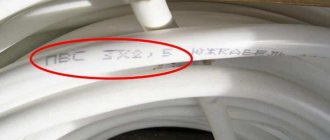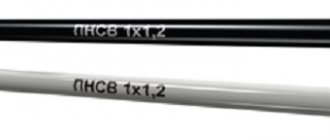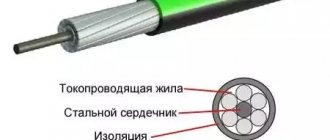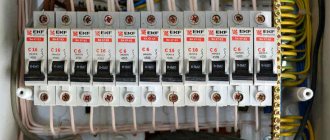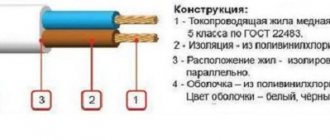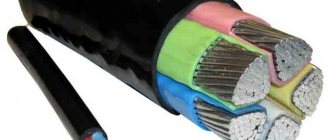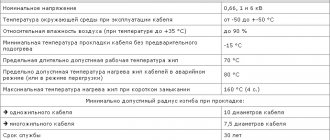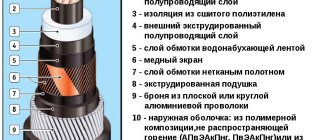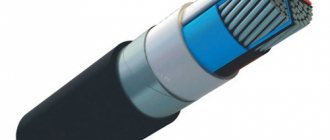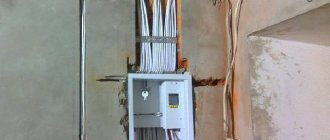The development of electrical networks and a significant increase in the number of consumers leads to numerous connections. Which is not possible to do with ordinary bare wires due to the danger of jamming and other factors. Therefore, the classic lines made with bare wire were replaced by SIP wire, which managed to occupy a niche for both household and industrial consumers. Such popularity of SIP was made possible due to a number of advantages in comparison with other brands.
Explanation of SIP markings
In comparison with other brands, SIP wire is a current-carrying element for transmitting electricity, which is deciphered by the three letters of the name:
- C – means that the wire is self-supporting;
- And - indicates the presence of insulation around current-carrying conductors;
- P - indicates that this is a wire, despite the presence of an insulating coating and branching along the cores, which is why it can be equated to a cable.
Consider an example of such a designation - SIP-1-3×20+1×25-0.4, here SIP-1 indicates the brand, 3×20 indicates that three insulated conductors have a cross-section of 20 mm2 each, 1×25 means that the neutral core has a cross-section of 25 mm2, 0.4 is the rated voltage for this model.
Depending on the specific brand, there are five main types of SIP wire, designated by the corresponding numbers after the letter designation. There may be one letter at the end, indicating design differences and operational features. These differences in SIP brands are determined by design parameters, so it would be more appropriate to consider them using specific examples.
How to correctly install SIP-4: choosing fittings
To install SIP-4, you need to use special fasteners. The appropriate fittings allow you to quickly and without harm to the insulation of the cores, lay the wire along the facade of the building, secure it to a pole and other structures. To connect current-carrying wires to each other, you must use suitable couplings with torque tension.
The main purpose of reinforcement is that it is indispensable when creating connections and other tasks. The fittings for this type of electrical products are special linear elements for the main line, the voltage of which is no more than 0.6/1 kV. Laying can be carried out on the facade, supports for overhead lines. Thanks to special fastening elements, it is possible to connect new subscribers and carry out various work at the substation. Moreover, fittings are used to contact insulated wires with bare wires, while outdated electrical networks with wires without insulation are being reconstructed into more modern self-supporting ones.
Fixing the wire requires the use of various elements. Fittings for insulated wire include:
- clamps - depending on the purpose and the support used, a variety of elements are used: from anchor to supporting and branch;
- brackets;
- insulated tips;
- special clamps for installing self-supporting insulated wires that do not have a supporting core;
- sleeves;
- bandage strip, clamp or yoke;
- tensioning tools.
When installing self-supporting wires, you need to know that durable reinforcement is the key to safe and qualified installation of SIP-4. Only if you choose fittings of high strength and reliability, and competently carry out all the necessary work, will it be possible to create a wear-resistant, high-quality overhead power line that will function uninterruptedly for many years without the need for repairs, short circuits and other emergencies.
Design
Structurally, all types of SIP wires contain cores made in a certain shape with a given number, one of which can serve as a carrier string for the line.
They differ in type as follows:
- SIP-1 is a four-core wire in which each of the cores is represented by conductors twisted relative to each other. In this brand of SIP, three of them are designed for three phases and are equipped with thermoplastic insulation, and the fourth is for the neutral terminal, but it is not insulated. In a neutral conductor, the central wire is made of steel and acts as a load-bearing wire. If there is a letter A (SIP-1A) at the end of the marking, the zero terminal will be equipped with insulation.
Rice. 1: SIP-1 wire design - SIP-2 is the same four-wire version as the previous one, with the only difference being that the neutral wire is insulated. In the classic version, the neutral core is insulated with thermoplastic polyethylene, and in the SIP-2A brand, with cross-linked polyethylene, just like the phase ones. The second option is used for areas with significant exposure to atmospheric factors. Like the previous brand, this SIP is used in lines up to 1 kV.
Rice. 2: SIP-2 wire design - SIP-3 - unlike previous brands, is a single-core version of the current-carrying wire. Structurally, in the center of this SIP there is a steel supporting wire, which is surrounded by aluminum current-carrying conductors. It is used in high-voltage lines with a voltage of 6 - 35 kV for laying phases over long distances.
Rice. 3: SIP-3 wire design - SIP-4 is a pair system in which each core has its own pair, but, unlike the previous ones, it does not have a supporting element and a neutral wire. Therefore, this brand cannot be used for installing lines, since there is a possibility of it breaking when exposed to wind loads. Thermoplastic polyethylene is used as insulation here. There is a version of the brand with the letter N (SIP-4N), which indicates that the current-carrying elements are made of aluminum alloy; if the letter H is absent, the specific brand uses pure aluminum wire.
Rice. 4: SIP-4 wire design - SIP-5 - completely identical to the previous brand - also has a paired number of cores and does not contain a neutral wire with a supporting element. The only difference is the type of insulation covering the conductors; in the SIP-5 and SIP-5N brands it is cross-linked polyethylene, which allows you to increase the operating temperature limit by up to 30%.
Rice. 5: SIP-5 wire design
Decoding SIP wires
The abbreviation of wire brands of the SIP group stands for:
- C - self-supporting (usually a separate core is the carrier);
- I - insulated (the insulating layer is made of thermoplastic/light-stabilized cross-linked polyethylene XLPE);
- P - wire (the product is sometimes mistakenly called a cable).
In the marking of SIP wires, the letters A, N and T are sometimes found, for example, SIP-1A. Here's what they mean:
- A - the null core is insulated;
- N - conductors carrying electric current are made of aluminum alloy;
- T - the insulating layer can withstand increased heat, up to +90 C (up to +120 C for a short time).
Specifications
When choosing a specific brand of SIP wire, it is important to pay attention to the compliance of the characteristics and parameters with the individual requirements of the consumer and the installation method.
To do this, the following technical characteristics are taken into account:
- Number of cores - as a rule, models with the number of current-carrying elements from 1 to 4 are used;
- Cross-section – for different SIP models, this parameter varies from 16 to 240 mm²;
- Voltage class - there are two categories in total - up to 1 kV (SIP-1, 2, 4, 5) and up to 35 kV (SIP-3);
- Temperature regime - implies a normal operating temperature at which the wire will transmit electricity for a long time without losing its parameters;
- Permissible short-term heating - can occur in emergency modes, but should not exceed more than 8 hours of the annual load;
- Bending radius - determines the ability to bend the wire without compromising the mechanical strength of the insulation and its dielectric properties.
All technical characteristics compared for all brands are shown in the table below:
Table comparing characteristics of SIP brands
| Wire brand | SIP-1 | SIP-2 | SIP-3 | SIP-4 | SIP-5 |
| Number of current-carrying cores, pcs. | 1 ÷ 4 | 1 ÷ 4 | 1 | 2 — 4 | 2 — 4 |
| Core cross-section, mm2 | 16 ÷ 120 | 16 ÷ 120 | 35 ÷ 240 | 16 ÷ 120 | 16 ÷ 120 |
| Zero core, bearing | aluminum alloy (with steel cores) | aluminum alloy (with steel cores) | absent | absent | absent |
| Current-carrying core | aluminum | aluminum | aluminum alloy (with steel cores) | aluminum | aluminum |
| Voltage class, kV | 0.4 ÷ 1 | 0.4 ÷ 1 | 10 ÷ 35 | 0.4 ÷ 1 | 0.4 ÷ 1 |
| Core insulation type | thermoplastic polyethylene | light stabilized polyethylene | light stabilized polyethylene | thermoplastic polyethylene | light stabilized polyethylene |
| Operating temperature | -60оС ÷ +50оС | -60оС ÷ +50оС | -60оС ÷ +50оС | -60оС ÷ +50оС | -60оС ÷ +50оС |
| Permissible heating of cores during operation | +70оС | +90оС | +70оС | +90оС | +90оС |
| min wire bending radius | not less than 10 Ø | not less than 10 Ø | not less than 10 Ø | not less than 10 Ø | not less than 10 Ø |
| Life time | at least 40 years | at least 40 years | at least 40 years | at least 40 years | at least 40 years |
| Application | branches from overhead lines; — power supply to living quarters; - household construction laying along the walls of buildings and structures. | branches from overhead lines; — power supply to living quarters; - household construction laying along the walls of buildings and structures. | for installation of overhead lines with voltage 6-35 kV | branches from overhead lines; — power supply to living quarters; - household the buildings; — laying along the walls of buildings and structures. | branches from overhead lines; — power supply to living quarters; - household the buildings; — laying along the walls of buildings and structures. |
What is the difference between SIP 4 and SIP 5?
The SIP 4 and SIP 5 brands are very similar; even a professional cannot always immediately distinguish them. Their main difference is the material of the insulating layer.
For SIP 4 the insulator is made of ordinary thermoplastic polyethylene, for SIP 5 - from light-stabilized XLPE cross-linked using silane technology. The advantages of the latter are:
- maintaining short-term heating up to 250 C;
- the presence of “memory” (return to the original shape after compression/overheating);
- resistance to low temperatures.
SIP wires 1,2,3,4 (5) have proven themselves to be excellent when laying new overhead power lines, repairing existing ones, as well as supplying electricity to domestic and industrial consumers of electricity. The scale of use of SIP wires is constantly growing, and statistics on their use indicate the safety and reliability of these brands of wire products.
Laying conditions
Due to the fact that laying SIP does not require any special skills, it can be done either at home or by the enterprise’s own resources without the involvement of a specialized organization. Laying can be carried out both on supports and on structural elements of buildings and structures. As a rule, fastening to walls is much easier than on a free-standing support.
Therefore, consider the conditions for installing SIP wire on reinforced concrete supports:
- Since the self-supporting insulating wire has an insulated sheath, it is important to provide a suspension that prevents damage to the dielectric layer. To do this, plastic rollers, grips and thimbles are installed, along which the wire can move freely.
- During the installation process, it is forbidden to drag the SIP along the ground or tree branches, as these can damage its insulation.
- To join different sections of SIP, sealed piercing-type clamps are used. Thanks to this design, it is possible to tap a line from an existing one even under voltage.
- Before fixing it on the support, the SIP wire must be pulled out through the moving element (for SIP brands from 1 to 3 using a dynamometer until the normalized load is set). After stretching, it is fixed at the fixation points.
All fasteners are factory-made, so they can be found complete with self-supporting insulating wire, which will greatly simplify the task.
Rice. 6: Example of fastening a SIP wire to a support
Branch SIPs
Characteristic
Branch SIPs consist of 2 or 4 insulated aluminum wires with a cross-section of 16 or 25 mm2, twisted during the manufacture. Branch wires do not contain a carrier wire and can serve one or more individual consumers, they can also be used over short distances as a backbone for lighting public places; These wires are of the self-supporting type.
Phase conductor
lived
— aluminum, round, multi-wire compacted;
insulation
- black extruded light-stabilized silanol cross-linked polyethylene;
markings
- numbers or colored stripes or longitudinally pressed marks.
| Core cross-sectional area, mm2 | Diameter, mm | Harness weight, kg/km | Linear resistance at 20°C, Ohm/km | Current strength at 20°C, A | Voltage drop, V/km | Core tensile strength, kN | |||
| veins | insulated cores | tourniquet | |||||||
| min | Max | ||||||||
| 2×16 | 4,85 | 7,2 | 7,7 | 14,0 | 137 | 1,91 | 93 | 3,98 | 1,90 |
| 2×25 | 5,9 | 8,5 | 9 | 17,2 | 210 | 1,20 | 122 | 2,54 | 3,00 |
| 4×16 | 4,85 | 7,2 | 7,7 | 17,8 | 274 | 1,91 | 83 | 3,28 | 1,90 |
| 4×25 | 5,9 | 8,5 | 8,9 | 20,2 | 420 | 1,20 | 111 | 2,18 | 3,00 |
Application, advantages and disadvantages
Due to the presence of insulation, SIP has a fairly wide scope of application. It is most often used to introduce electricity into a building, and thanks to the outer layer of insulation, additional measures and devices are not required when passing through walls. Also, a self-supporting insulating wire can be used for local wiring of networks throughout the facility or when connecting subscribers to the lines of an energy supply organization. A separate area of application for SIPs are trunk lines that provide power supply to entire villages or distribution substations.
Compared to other brands of cable and wire products, SIP has a number of advantages, namely:
- SIP wire has significantly lower reactance compared to bare wires;
- Does not require the installation of additional insulators at points of attachment to supports, walls and when entering the building due to the presence of an insulating layer;
- Takes up less space due to the fact that the wires are collected together;
- Not subject to corrosive destruction due to the presence of a protective layer;
- Not afraid of overlap of adjacent phases under strong wind loads;
- Makes it difficult to illegally take power by throwing on wires;
The disadvantages of SIP wire include the greater weight of a linear meter, which is why the spans need to be reduced and supports installed more often. As well as the need to arrange additional insulation for certain categories of premises and consumers.
How it differs from bare wires: main advantages
Electrical products with this marking have many positive qualities, which include:
- high tensile strength, which allows the wire to withstand wind loads and the fall of massive branches from trees;
- ease of tension;
- the insulating layer is made of a safe modern material that does not allow the wires to rust, it also protects the wires from the influence of moisture, ice formation and minimizes the likelihood of a short circuit among the phases;
- SIP-4 can be operated in adverse conditions - the network will operate uninterruptedly at temperatures from -60 to +50 degrees C;
- Good flexibility - the smallest bending radius is 10 outer diameters of the wire, making it easy to create various turns during stretching;
- increasing the reliability of power supply - even if the insulation is broken, the design of the wire prevents the spread of moisture;
- reduction of commercial electricity losses - it is much more difficult to connect to an isolated line based on SIP-4, unauthorized electricity supply becomes much more difficult or is completely blocked;
- branches and branches to connect subscribers are created using special piercing fittings so that installation does not require de-energizing the main line.
Another advantage of SIP-4 wires is their long service life, amounting to several decades.
Main manufacturers
To avoid troubles when purchasing a wire or cable, you should pay attention not only to the main parameters of the product, but also to its manufacturer. Since low-quality models may have a smaller cross-section, low dielectric resistance to various types of influence, etc. If you have already purchased a self-supporting insulating wire and are not sure of its quality, check whether the cross-section corresponds to that stated in the passport. How to determine the cross section at home is described in the corresponding article -.
If you are just going to buy SIP, pay attention to the following manufacturers:
- Kama cable;
- Rybinskcable;
- GC "Sevkabel"
- Moscabel.
Using wires from the above-mentioned factories, you can be sure that they comply with the declared characteristics.
Methods of delivery and unwinding of products marked SIP-4
For ease of sale, wires with a cross-section of no more than 25 mm2 are most often supplied in coils of 50, 200 or 400 m. The length can be as specified by the consumer. The main thing is that the weight of the bay does not exceed 25 kg. It can be unwound from the inside without the use of additional equipment.
In other cases, SIP-4 is supplied on drums and requires unwinding during installation. If the cable length in general does not exceed 100 m and the distance between adjacent supports reaches no more than 25 m, then unwinding can be done manually. Under other conditions, special equipment is required. It is a winch with a cable and rollers on supports. During operation, the rollers are replaced with intermediate clamps.

